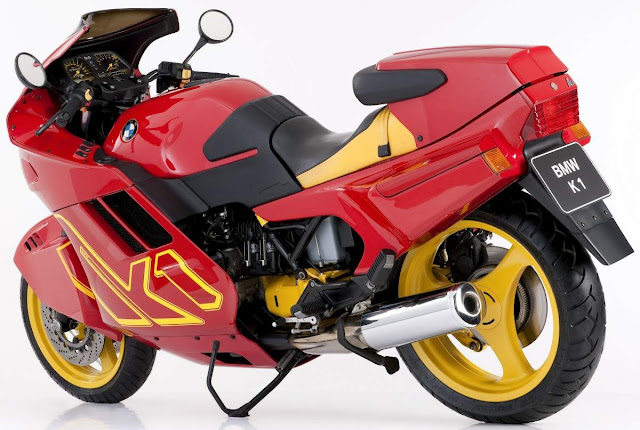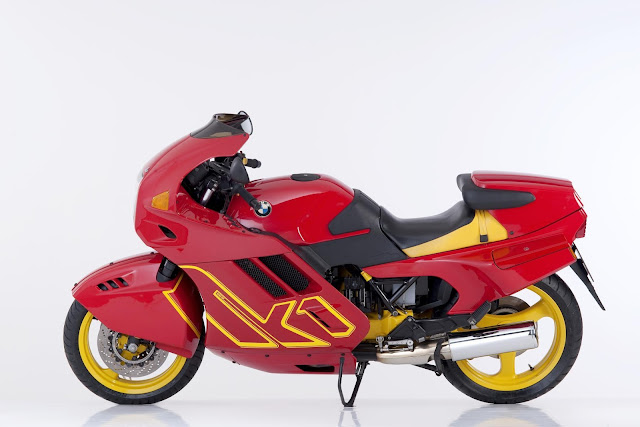BMW K1
For such a long, heavy bike the K1 went round corners well, and it remained stable in a straight line to its top speed of over 1-fOmph (225km/h).
The Kl’s radical look, thanks mainly to its streamlined, all-enveloping bodywork, would have been a big surprise coming from any manufacturer, let alone traditionally conservative BMW.
Few such striking bikes have ever come from such an unlikely source as the big,
1 bold and colourful K1 with which BMW stunned the motorcycling w'orld in 1989. In recent years the German firm has introduced many innovative and eye-catching machines. But until the K1 appeared, the BMW’s name was synonymous with efficient but unexciting tourers.
The K1 had been given its big. aerodynamic coat for two main reasons: firstly as a radical twowheeled statement, and secondly because BMW had decided to restrict its power output to lOObhp. the voluntary German limit, so the bike needed all the help it could get to boost performance. The big front mudguard, all-covering fairing, swoopy seat and built-in panniers helped the K1 to a top speed of 145mph (233km/h), faster than most bikes managed from lOObhp.
Those 100 horses were produced by a 16-valve version of the liquid-cooled 987cc four-cylinder motor from the K100RS sports-tourer. Unlike Japanese fours, the German firm’s K-series engines had cylinders lying horizontally and arranged along the line of the bike. The K1 motor gained lObhp through its more sophisticated fuel-injection system, new- exhaust and a few other tuning tricks.
Beneath the bold bodywork, the Kl’s chassis was conservative. It was based around a steel space-frame that used the powerplant as a stressed member. Suspension was a combination of BMW K1
Marzocchi front forks and BMW’s well-proven arrangement of a single rear shock acting on the swingarm/shaft-drive housing. Brakes were from Brembo; cast wheels carried wide, low-profile radial rubber.
High speed cruising
Despite being BMW’s most powerful ever roadster, the K1 was in a modest state of tune. Its engine was docile at low speeds, pulling cleanly from tickover right to the 85()()rpm redline with no real step in its power delivery. The bike cruised effortlessly at high speed, with a burst of acceleration in hand when required. But acceleration was good rather than exceptional, due partly to the bike’s 5701b (259kg) of weight, and the motor vibrated noticeably above 5000rpm.
Handling showed much the same characteristics: it was not racer-sharp but fairly laid-back, requiring a reasonable amount of effort at the handlebars. One advantage of that was that the Kl remained reassuringly stable all the way to its top speed, swallowing high-speed curves without a twitch. The forks were excellent, and although the rear suspension was a little harsh the Kl tracked well over bumps.
Blown BMW: the Luftmeister K1
The ultimate fast BMW was a turbocharged K1 special from Luftmeister, the California-based tuning company. Fitting an IHI turbocharger beneath the K1's bulky bodywork doubled peak output to approximately 160bhp at the rear wheel, with minimal engine strengthening work required. The BMW's shaft final drive made altering its gearing difficult, but with a suitably tall ratio the Luftmeister K1 was good for over 185mph (298km/h).
It was when there were serious distances to be covered that the Kl came into its own. Its big fairing not only boosted performance but diverted wind from e%er\where but the rider's helmet, allowing high cruising speeds. Fuel economy and the broad seat added to the comfort. Annoy ingly for such a good long- e, the b ke’s wind-smoothing rear p cketv mmeh r enough to carry a toothbrush inniers impossible to fit. The K1 was a success for all that.
It was a fine sports-tourer. And more importantly, it was a unique anc striking machine that began BMW’s move from one of the most conservative of bike manufacturers to one of the most bold and imaginative.
The ultimate fast BMW was a turbocharged K1 special from Luftmeister, the California-based tuning company. Fitting an IHI turbocharger beneath the K1's bulky bodywork doubled peak output to approximately 160bhp at the rear wheel, with minimal engine strengthening work required. The BMW's shaft final drive made altering its gearing difficult, but with a suitably tall ratio the Luftmeister K1 was good for over 185mph (298km/h).
The front wheel’s huge, wheel-hugging mudguard was an important part of the Kl’s style, as well as combining with the fairing to give the smooth air flow that increased top speed. Although the BMW was too heavy to be a sports bike, its Marzocchi front forks helped give good handling. Brembo. another Italian firm, supplitd thi front brake system.
Specification BMW K1 (1989)
- Engine Liquid-cooled dohc 16-valve inline four
- Capacity 987cc (67 x 70mm)
- Maximum power 100bhp @ 8000rpm
- Transmission Five-speed, shaft final drive
- Frame Tubular steel spaceframe
- Suspension Telescopic front; monoshock rear
- Brakes Twin discs front; disc rear
- Weight 5701b (259kg)
- Top speed 145mph (233km/h)























0 comments: